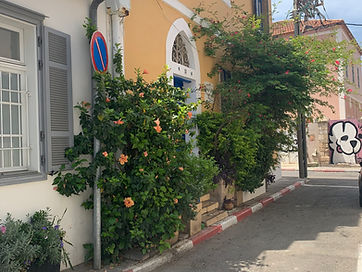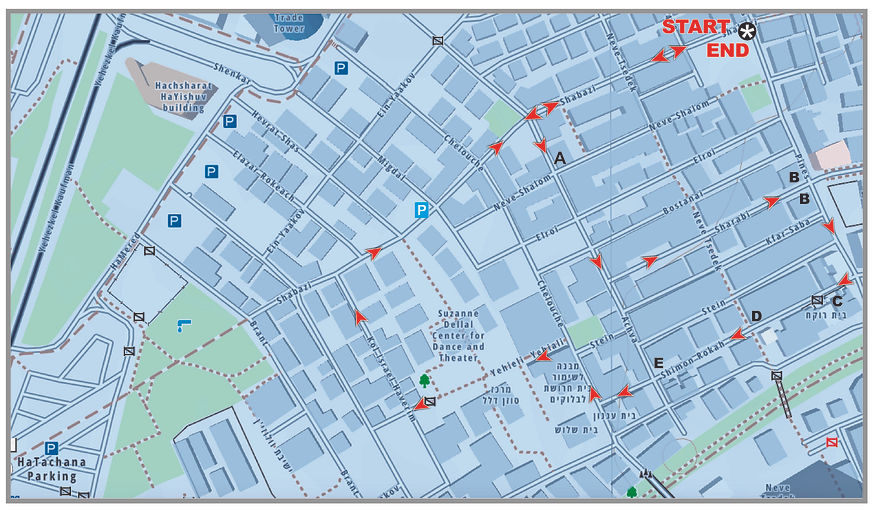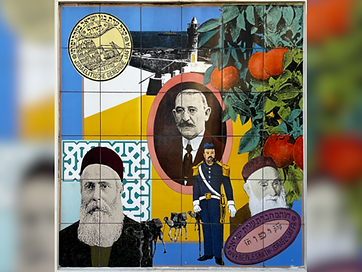A walk through the neighborhood of Neve Tzedek
Neve Tzedek (the Abode of Righteousness) was the first all-Jewish suburb to be built outside the mixed Arab-Jewish city of Jaffa in 1887, and to a degree can be considered the model for the later development of Tel Aviv. By the 1950s, it was experiencing decay, but is now undergoing high-end rejuvenation. This pretty circular walk includes its interesting buildings and the fascinating people who once lived here. It starts at the corner of Pines St. and (Shalom) Shabazi St., but can be taken up anywhere along the route shown in the map below.
The must-have guide for exploring in and around Jerusalem
"In and Around Jerusalem for Everyone - The Best Walks, Hikes and Outdoor Pools"
For FREE, speedy, home, courier service from Pomeranz Booksellers in Jerusalem click here (tel: 02-623 5559) and for Amazon click here. To view outstanding reviews click here.
Time: Almost half a day if you like window-shopping and wish to visit the Nahum Gutman Museum and visit the HaTahana.
Directions and parking: For a large and convenient parking lot, enter “Hatahana Parking” into Waze. To then get onto the circular hike, go through the park adjoining the parking lot in the direction away from the sea and continue along Shabazi St until you come to the corner of Shabazi St and Achva St. Turn right onto Achva St and you are close to the beginning of our circular walk.
Type of walk: Circular
Public transport: Enter “Shabazi St.” into Moovit. The bus stop is a bit further along Shabazi St. than its intersection with Pines St. From the Shalom Towers it is about a 540-meter/ 5-minute walk to the beginning of the walk. The closest light rail is Elifelet Light Rail Station which is about a 10-minute walk to the beginning of the walk.

Outside the Nahum Guttman Museum
Beginning, then decay, and now the rejuvenation of Neve Tzedek
The 1880s was a time of increased Jewish immigration to Palestine, primarily due to the Ashkenazi First Aliyah from Eastern Europe. Much of this immigration was to agricultural settlements, but some immigrants moved to cities such as Jerusalem and Jaffa.
A new suburb of Jaffa was established in 1887 by some Jewish families who wished to escape the crowded conditions in Jaffa, then a predominantly Arab city. Their aim was to establish a religious neighborhood with modern housing just outside Jaffa. Their model was the suburbs of Western Europe. They named their new suburb Neve Tzedek, which means Abode of Righteousness. This name reflects the vision of its founders who were predominantly religious immigrants. It was not exclusionary, since most immigrants to Palestine in this period ere religious Jews.
The three individuals most involved in its establishment were the businessman Aharon Chelouche, who was Sephardi, a money lender and trader in silver and gold, who moved to Neve Tzedek in 1883, Shimon Rokach, a wealthy Ashkenazi from a Hassidic family who owned much of the land of this area which had been purchased from an Arab sheikh, and Akiva Weiss, a Zionist activist.
Aharon Chelouche was originally from Algeria. In addition to his house, he erected an adjoining synagogue. His two sons owned a store, and then a factory for building supplies. They were also contractors for many of the homes in Neve Tzedek. Shimon Rokach was a community leader and very much involved in charitable ventures. His colleague, Sephardi Chief Rabbi Ya’akov Meir, had this to say about his friend after his passing away: “I remember when the departed was able to celebrate the first house he erected in Neveh Tzedek, having been the first to plunge the stake into that hill of sand, in the desolation of the wilderness – which he removed – and a stake for all the surrounding neighborhoods. How happy he was, and how he laughed with joy! When I asked him, “My friend Shimon, what is the meaning of this laughter?”, he answered with radiant, beaming countenance: “How could I not laugh and be happy, having been privileged to add another settlement to a desolate land, despite our opponents who strove with all their power to impede my way?” The departed then prophesied: “Now I look ahead, and it is not far off: around this settlement of ours there now will multiply new settlements and neighborhoods, and we will be able to establish for ourselves a purely Jewish center,” and his good heart saw correctly, for is not Tel Aviv the scion of Neveh Tzedek? Who knows, if there had been no Neveh Tzedek, whether we would have even Tel Aviv and its suburbs?”
You will notice in your walk that the original homes here are of a different class from say the homes in Nachla’ot in Jerusalem that were built during this period. Those were built as modestly-priced housing for people of limited means and were sold almost at cost. The homes in Neve Tzedek were built for bourgeoisie, and are comparable in quality to the homes of the German Templars, as seen for example in Serona.
Neve Tzedek thrived. A station for a railway connecting Jaffa and Jerusalem was built close by in 1892 and this provided a boost to the neighborhood. By the 1920s, it was attracting artists, writers, and intellectuals, particularly because of its low price of housing compared to Tel Aviv, and it became a hub of Jewish cultural and intellectual life. Among its residents were the poet Chaim Nachman Bialik, the painter Nahum Gutman and the writer Shmuel Yosef Halevi Czaczkes. Czaczkes later changed his name to Shmuel Yosef Agnon and is best known by his Hebrew acronym Shai Agnon.
However, from the 1950s onwards as the city of Tel Aviv moved northwards, the neighborhood began a slow decay. Many of the houses were abandoned and over time were close to collapse. However, due in large part to the Suzanne Dellal Center establishing itself here and renovating deserted school buildings, the neighborhood experienced a renaissance beginning in the 1980s. It is now one of the most fashionable and expensive suburbs of Tel Aviv.
In this walk, you will see the decay that occurred in this neighborhood, although it is fast disappearing. You will also soon appreciate that this is now a trendy place with cafes, bars, galleries, boutiques, artists’ studies, and small shops. It has also become a popular tourist destination.

The outside of the Aboulafia home

The outside of the Rokach home
THE WALK:
-
The walk starts at the corner of Pines St. and (Shalom) Shabazi St. Walk down Shabazi St. in a westward direction. Note its upscale stores.
-
Turn left when you come to Achva St. By way of contrast, look at the abandoned house at the corner of Achva St. and Neve Shalom (point A on the map at 21 Achva St.). This was the home of Rabbi Avraham Isaac Kook for 15 years before he moved to Jerusalem on being appointed Ashkenazi Chief Rabbi of Jerusalem.
Rav Kook was recruited for Jaffa as being a different, more modern type of rabbi than the predominantly East European rabbis present in Palestine. He already spoke Hebrew and was knowledgeable in aspects of the Enlightenment. However, he also came from Eastern Europe, was a graduate of the prestigious Volozyn Yeshiva, and was an expert in all aspects of halacha and kabbala. He moved to Neve Tzedek in 1904. He had a yeshiva in his home and befriended the intellectuals of the neighborhood. He left Neve Tzedek in 1919 when he was appointed Ashkenazi Chief Rabbi of Jerusalem, and soon after this Ashkenazi Chief Rabbi of Israel. He also had a yeshiva in his home in Jerusalem, and this became the basis of the yeshiva Mercaz HaRav. Rav Kook is considered one of the great Jewish philosophers. He was a messianist. One of his important contributions was to encourage religious Jews to become fully engaged with the state, although the haredim opposed this approach. The abandoned home you see is typical of the fate of many of the homes here from the 1950s, although many are now being restored.
-
Turn left onto Sharabi St. This attractive street contains original homes, although many have been renovated. At its intersection with Pines St. are the Twin Homes (#2). These are two homes built by Aharon Cheloushe for his first two grandchildren from different sons (#2).
These homes were supposed to be alike to obviate any rivalry, hence their being known as the Twin Houses. In actuality they are not quite alike. One is slightly larger than the other, and they were therefore allocated by lottery. They were built in 1915 with material from the family’s workshop and were intended to incorporate traditional styles commensurate with the rest of the neighborhood — hence the arched windows, ornate balconies and decorative details, although blended with contemporary touches such as clean lines.
-
Continue down Pine St. to Shimon Rokah St. and turn right onto this street. On the left is the Rokach House (C)
Built in 1887, Rokach House at 36 Shimon Rokah St. was the home of one of the orginal founders of Neve Tzedek, Shimon Rokach. Its design reflects the Art Nouveau architectural style popular in this period. It has a large copper dome. His grandchildren have made the home into a museum dedicated to his life and work and the history of the beginnings of this community. Group tours can be pre-arranged through this website.
-
Further along Rokah St. is the Nahum Gutman Museum (E) on your right at 21 Shimon Rokah.
This is the original home of Nahum Gutman. If you are a visitor or recent immigrant to this country, there is a good chance that you have never heard of this artist, but he was an important figure at this time and place. His artwork is displayed in a number of prominent places in Tel Aviv.
Nahum arrived in this country with his family in 1905 and they moved to Neve Tzedek, although they were not the initial owners. This building was built in 1887 and is one of the original buildings of the neighborhood. Nahum studied at the Bezalel School of Art in Jerusalem and between 1920 to 1925 studied art in Vienna, Berlin and Paris, then centers of modern art. He was influenced in particular by Henri Matisse, Rasoul Dufy, Henri Rousseau and the French Orientalists. As explained in the museum, he fused this modern art with vividly colored, erotic, fantastic views reflecting Jewish national revival in the Land of Israel. Together with others, he sought to establish an artistic language for Zionist projects.
In one section of the museum is a display of his paintings and in another his sculpture. On another floor is the exhibit Wormhole, an attractive exhibit which has nothing to do with this artist. Tickets for admission are purchased in the museum store. Admission is 30 NIS and for students and seniors 15 NIS. The museum is open Monday to Thursday 10.00 a.m. to 4.00 p.m., Friday 10.00 a.m. to 2.00 p.m., Saturday 10.00 a.m. to 3.00 p.m. and it is closed on Sunday. Their phone number is 03 516 1970.
-
The corner house on Shimon Rokah St. and Achva St (E) on your left is the home of the Abulafia family.
After the death of her husband, the Abulafia widow rented the attic of her home to a writer Shmuel Yosef Czaczkes. He would eventually become known by his penname Shai Agnon, and would become a Nobel prizewinner for Hebrew literature. Agnon befriended the intellectuals in the neighborhood. All tour guides will doubtless tell you about Agnon’s crush on Aharon Chalouche’s granddaughter. He was able to see her on the balcony of the Chalouche home across the road from his room. However, such a match as this would not have been approved of by the Chalouche family, as Czaczkes was no more than a writer. He mentions his crush for her in his book “Yesterday and the day before yesterday,” but makes no mention of the Chalouche home. Rather, in his book he describes his room looked out over the sea. The original Chalouche home is no longer evident, but their synagogue to the south of their former home still exists. The family workshop owned by his sons was next door to their father’s home.
-
Turn right onto Chelouche St and then take the first left onto Yehieli St. This will bring you to the Suzanne Dellal Center (F) at 5 Yehieli St. You will come to a large courtyard. Immediately on the wall on your left as you enter the courtyard is the impressive ceramic print work by the artist David Tartakover, who also lived in the neighborhood. It was created for the inauguration of the center and depicts in vivid colors the history of Neve Tzedek. In the center is a picture of Shimon Rokach and beneath this Aharon Chelouche, the two founders of Neve Tzedek.
The Suzanne Dellal Center was founded in 1989 with the goal of producing world-class dance productions and mixed educational activities. It was set up in school buildings of the neighborhood that were no longer functioning. These buildings have since been renovated. The Center is the home of the Batsheva Dance Company and Inbal Dance Theater and it contains four concert halls, rehearsal studios, restaurant and café. There are also events and performances in the large plaza.
-
Exit the center by the continuation of Yehieli St and then turn right onto Kol Yisrael Haverim St. When this street comes to an end, turn right along Shabazi St. to return to Pines St. and the end of the walk.
Nearby places of interest:
You may wish to visit the nerby HaTachana, which was the site of the railway station for the Jaffa-Jerusalem railway. It was built in 1892, but the station fell into disuse when this part of the railway closed. It contains some of the old buildings, some old railway carriages, stores and restaurants. It is not as popular or exciting as say Serona. To get there, turn left on Shabazi St. and walk through the park. Take the road just before the parking lot to the left and this will lead you to HaTachana.

Map of walk through Neve Tzedek

Picture of the founders of Neve Tzedek at the Suzanne Dellal Center. In the center is Shimon Rokach and bottom left is Aharon Chelouche.
Links to the best family activities, hikes and historic sites in the GOLAN, EASTERN GALILEE, UPPER GALILEE, LOWER GALILEE, JORDAN VALLEY & LAKE KINNERET, the SHEFELAH, TEL AVIV-YAFFO and surroundings, NORTH of TEL AVIV, and SOUTH of TEL AVIV.